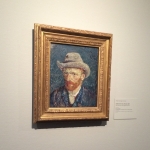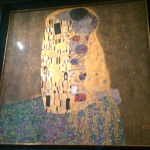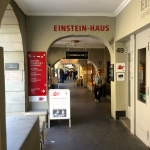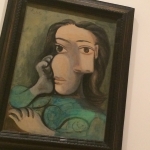Van Gogh Museum in Amsterdam
The Vincent Van Gogh museum in Amsterdam was extraordinary. It is so often that you hear about amazing artists such as Vincent Van Gogh, but it is rare to really experience and see an enter collection of beautiful work. Van Gogh has a unique style that is ingenious.
I liked the set up of the museum because each section explained what was going on in the life of Van Gogh and then showed the paintings from this period. From gaining insight into his life, I was able to have an understanding and visually see how his work reflected on his life.
No pictures were allowed in the museum, but I did not know this until I took a picture. As soon as I snapped a photo with my camera, a man approached me and sternly told me that I was not to take any more photos. Luckily I was able to capture a nice shot of one of his self portraits. Through his career Van Gogh painted many self portraits. As an artist he struggled to make a living and often painted peasants of flowers. These were his best options since he could not afford to pay models. Since he was limited on subjects and rarely commissioned to produce portraits, Van Gogh painted himself. He used himself to test out different techniques and develop his skills; he also thought self portraits to be very important, as he felt, they would always be in demand.
The Belvedere in Vienna
The Belvedere in Wein was a stunning museum that sat on a stunning plot and in a stunning building.Not only were there amazing gardens, but a spectacular view of the entire city. The masterpieces within the Belvedere covered a variety of topics. The Collections in the museum include work from the Middle Ages, Baroque, Classism/Romanticism, Biedermeier, Ferdinand George Müller forest, Historicism, Impressionism, Art Nouveau/Secession, Expressionism, Interwar period, art after 1945, and finally some contemporary Art. For me, the most interesting work was from the Impressionism and Art Nouveau collections.
Impressionism for many artists aimed to capture the impression of the moment this moment should be represented in a contemporary style and express modern views of life in society. The pieces of Impressionism in the Belvedere are works from such artists as Paul Cézanne, Edgar Degas, Vincent van Gogh, and Claude Monet. One of my favorite pieces from this collection was Cook by Monet (1882). The techniques used are absolutely exquisite and each detail is finished off perfectly, I even enjoy how the piece fades toward the bottom almost to be unfinished. This section of the Belvedere was completely impressive (pun intended).
Although the museum houses beautiful pieces from some of the most famous artists, the most notable pieces are the works completed (and uncompleted) by Austrian painter Gustav Klimt. The museum houses the largest collection of Klimt oil painting and all together 24 of his works; these include portraits, landscapes and allegorical scenes. Klimt is known for his huge contribution to avant-garde’s breakthrough in Vienna. He was also a founder of the Vienna Secession and its first president; with this he strived to renew the arts. Klimt was also extremely influential with his liberal portraits of ladies and risqué style. The most famous of his pieces in this museum is The Kiss (1908); not surprisingly, I was sneaky enough to snap a picture. In all I think the Belvedere was one of the most impressive museums inside and out!
Einstein Haus in Bern
Visiting Einstein’s house in Bern was an experience. Although there was not much to see in the building itself, I was able to watch a very informative video about Einstein’s life. Furthermore, I had the opportunity to walk the same rooms, and look out the same windows as one of the greatest minds of all time.
I had known about Einstein and his work with physics prior to visiting the museum, but there is so much more about his life that I was unaware of. First I learned about his love for music; he mainly played the violin, but he also played the organ and piano. While in Bern Einstein played mainly in small groups or alone, but music and playing the violin were very important through his entire life. Music allowed him to gain friendships throughout the world; for example, when he played music with Queen Elizabeth of Belgium, he gained friendship with the Belgian Royal Family. Einstein’s violin was named Lina; in his will this violin was to be handed down to his grandson Bernhard Caesar Einstein. I am not sure if Lina is still around today, but it would be pretty cool if she was still providing music!
The second part to Einstein’s life that I was unaware of was his involvement and influence on the United States government. After Hitler came into power and on March 10, 1933, Einstein declared that he would never set foot in Germany again. Then in 1933 he emigrated to the USA to work at Princeton University. In August of 1939 he wrote a letter to the United States that notified them of the danger that Hitler was possibility creating an Atom Bomb, and on September 1 WWII broke out. One month later Einstein became a US citizen, but he kept his Swiss nationality. In the USA, the Manhattan Project was started (to create an Atom Bomb) in 1942, Einstein was left out because he was seen as a security risk. I am not sure if he was even aware of the Manhattan Project, but in 1943 Einstein advised the USA Navy on high explosives. Interestingly, he was then shocked at the two atom bombs dropped on Japan. There was an obvious impact on his conscious, and Einstein wrote a letter in 1946 where he pleaded for a world government. He also sat on a committee for arms control and the promotion of peaceful use of atomic weapons.
From my visit to Einstein’s house in Bern, it is clear that he was a very well rounded intellectual who had enormous world influence. He not only was an incredible scientist, but he had a social impact and musical talent.
Museum Berggruen
While in Berlin, I was looking for museums to visit. One museum had caught my attention, Museum Berggruen. This museum houses work from Pablo Picaso, Paul Klee, Henri Matisse, Georges Braque, and Alberto Giacometti. There were over 100 magnificent Picassos and 60 Klee masterpieces. Surprisingly, all of the works within the museum come from the private collection of Heinz Berggruen (1914-2007). Heinz Berggruen was a Berliner in which this museum was founded in honor of; the museum is part of the Nationalgalerie and the building is in the neoclassical style. All of the art in the museum was fantastic, but I did have some favorites.
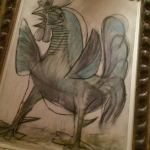
Some of the pieces I enjoyed the most were by Pablo Picasso(1881-1973). Picasso is among the most influential artists of the 20th century and an artist of all kinds; he was a painter, printmaker, sculptor, ceramicist, poet, playwright, and stage designer. Some of his innovative art thought and style led to the avant-garde art movement of Cubism. In the museum I saw many portraits in the Cubist style. These faces were completely distorted with each section representing a certain view of the face. Although seemingly none of the facial features are in the right spots, the style that Picasso uses is second to none and the distortions play off of each other to produce wonderful and original art.
Another piece that I really enjoyed by Picasso was Buste de femme (1923). This piece was interesting to me because of the materials used. When looking at the piece, it appears to be just another great Picasso, but when up close, is 3 dimensional. This was accomplished with to use of sand, of course photos do not do this piece justice; the work is absolutely fabulous with its grainy texture that can only be seen and really appreciated with the naked eye.
The art this museum holds is absolutely amazing and even more impressive that it came from a single collector!

